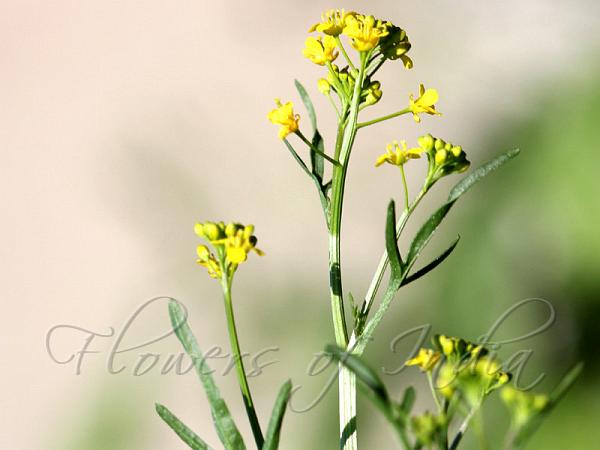|
| Yellow Fieldcress |
|

|

| File size | 80209 |
| Original date | 6/4/12 10:48 AM |
| Resolution | 800 x 600 |
| Flash | Flash did not fire, auto |
| Focal length | 100.0mm |
| Exposure time | 1/160s |
| Aperture | 5.6 |
| Focus Distance | |
| Metering Mode | Multi-segment |
| Camera make | Canon |
| Camera model | Canon EOS 550D |
| Sensor type |
|
|
|
|
Photo: |
Botanical name: Rorippa sylvestris Family: Brassicaceae (Mustard family)
Synonyms: Cardamine silvestris,
Synonyms: Cardamine silvestris,
Yellow Fieldcress can be identified by its yellow
flower petals, which are 4-8 mm long, and its pinnately divided leaves,
which have toothed margins. The wet habitat of the plant and its
creeping stems with fibrous roots are other good characteristics to
look for. Leaves are alternate, stalked, deeply pinnatifid. Basal
leaves are up to 10 cm long, 2-2.5 cm broad, with 6 main divisions per
side. Stem leaves are similar but smaller. All leaves hairless or with
very few short hairs. Leaf divisions are toothed. Flowers are borne in
racemes up to 10cm long, in leaf axils and at branch ends.
Flower-stalks are up to 4mm long in flower, expanding to 1cm long in
fruit. Inflorescence compact in flower, quickly expanding. Siliques up
to 1cm long, 1mm in diameter, cylindric but slightly compressed,
glabrous, with a beak to 1mm long.
Flowers have 4 ptals, distinct, spoon-shaped, yellow, hairless, up to 4
mm long, 1.5mm broad, rounded at the tip. Stamens are 6, erect, 4
larger and 2 smaller. Filaments yellow, glabrous, to 3mm long. Anthers
yellow, 1mm long. Ovary cylindric, green-yellow, glabrous, 2mm long in
flower, superior. Yellow Fieldcress is native to Europe and W. Asia. In
India it is found in Jammia and Kashmir.
Flowering: May-September.
| Identification credit: Gurcharan Singh | Photographed in Kashmir. |
• Is this flower misidentified? If yes,